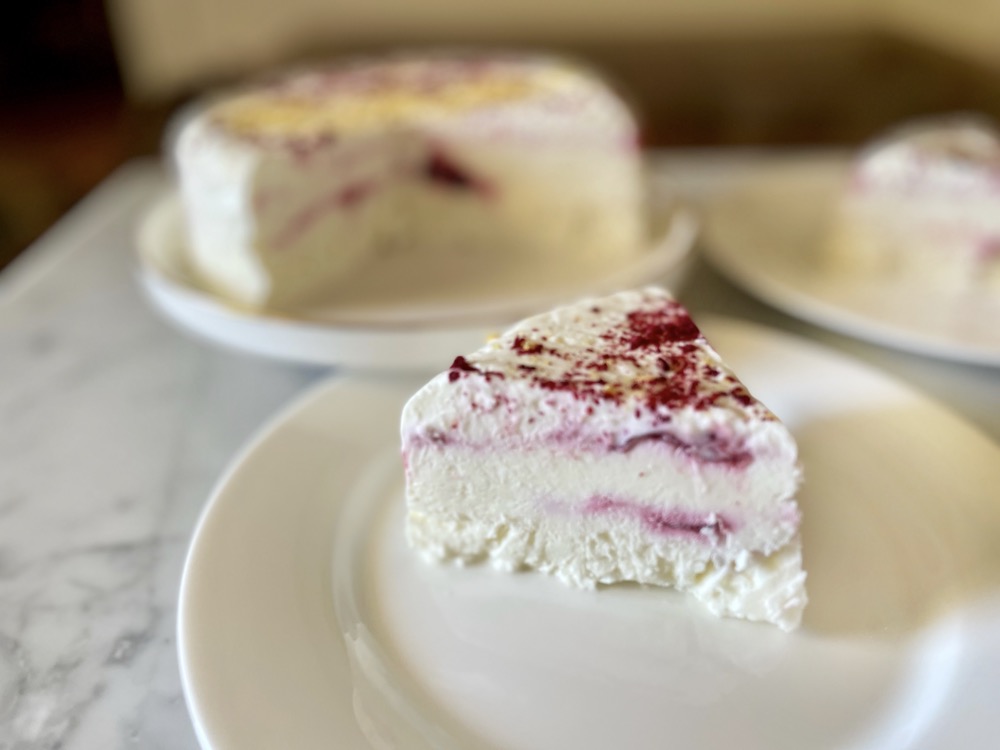In the famous book of the Italian gastronome, cook and writer Pellegrino Artusi, under the name of Torta Ricciolina or Torta di Tagliatelle, you’ll find two recipes dedicated to this cake. Today there are some different versions of Torta Ricciolina but, after all, they are all connected.
First of the recipe, I’d like to tell you something about the origins of this old and special cake. Special because tagliatelle, a fresh pasta usually served with ragù bolognese, here turn into a sweet recipe.

Tagliatelle cake: a traditional sweet.
It is typical of the Emilia area, created in the city of Ferrara, and it’s composed of three layers: the base is made of shortcrust pastry; the filling is made with almonds, amaretti cookies and candied fruit (if you don’t like them, please don’t turn your nose up, continue reading, what I propose is a version respectful of the tradition but less sweet); to complete the cake there is a last layer of tagliatelle.
Despite the name, to make the cake uses thin and narrow tagliatelle or, even better, egg tagliolini.

At the origins of the Tagliatelle cake.
The first notes that refer to the cake, which seems a stuffed tart, date back to the Renaissance. From a geographical and political point of view, the dessert originated in Ferrara, at the time ruled by the Este family. Legend has it that it was created taking inspiration from the long blonde hair of Lucrezia Borgia, lady of the city of Ferrara after her marriage to Alfonso I d’Este, Duke of Ferrara, Mantua and Reggio Emilia.
For this reason the origins of the cake are now claimed by all the major cities that were part of the Estensi estate and is also prepared in the areas geographically contiguous to their domains.
There are a Mantuan version, with several layers of puff pastry and without candied fruit, and a Modenese version (Modena was at one point the capital of the Este dukedom), with cocoa powder and Sassolino liqueur (typical of Modena).
Among the different recipes, there is also a Bolognese version, geographically close to Ferrara and Modena, sometimes without candied fruit (the recipe is deposited at the local Chamber of Commerce).
To be honest, along the Via Emilia there are different versions of the same recipe that, everywhere, is a holiday cake: there are those who prepare it for Christmas and those who prepare it for Easter, in any case this is a cake reserved for special events or Sunday lunch.
It has a rich flavor and you can bake it several days in advance, as it used to be done in the past, because it tastes better.
The Ricciolina cake of Artusi. And my version.
In his famous L’Arte di mangiar bene, the Italian gastronome wrote two versions of the same cake, determined to modify the first version (Recipe n. 578) to make it “kinder in appearance and more delicate in taste”. In the next one (n. 579) instead of pieces of candied fruit, there are just pieces of candied orange. A solution that I also like the most since I’m not a lover of too sweet sweets and candied fruit.
Trying to make this cake a little less sweet without breaking away from tradition, I read many recipes and did several tests. I had never prepared this cake and I thank the blog, but especially the readers, for the occasion that offers me to cook all the recipes of the Emilia-Romagna tradition.
Following my taste I tried with and without bitter oranges. I liked it both ways. As a lemon lover, grated rind is indispensable to me.
Just a last thing on the pasta (but read also food tips before the recipe): it must be fresh egg pasta.
Buona cucina, Monica
Keep In Touch
I like to see when you cook one of my recipes! If you try something, share the photo on Instagram tagging @tortelliniandco.

Food Tips
- Tagliatelle, indeed not! Tagliatelline, very very thin. You can use them fresh or dried (but always made with egg). If it’s fresh, just made, no problem because it will be soft and you can handle it easily. If it is dried egg pasta, proceed in this ways: put tagliolini nest in a pan with water, bring to a boil and cook without stirring or breaking the nest. Drain the nest with a slotted spoon or a turning spatula, place on a plate, let it cool, then gently widen the nest to cover the entire surface of the cake.
- If you don’t have bitter almond liqueur, some rum will be ok.
Tagliatelle Cake Recipe
Serves 6, round mold 14cm diameter
Ingredients
For the Base
200 g flour 00
100 g butter
40 g brown sugar
1 small egg
For the filling
150 g almonds, peeled
60 g sugar
1 egg
grated peel of 1 organic lemon
30 g candied bitter orange peel, if you prefer to use candied citron
1 teaspoon scarce of natural vanilla extract
50 g butter
1 tablespoon of bitter almond liqueur
1 nest of noodles, about 65 g
To finish, just enough of:
icing sugar
brown sugar
Directions
For the Base
In a bowl, mix flour and sugar. Add the cold chunks of butter and the whole egg.
Knead with your fingertips so as not to heat the butter too much until the dough is smooth and compact. Wrap in the film and let it rest in the fridge for about 30-40 minutes.
For the filling
Roast the almonds in a pan for a few minutes. Then coarsely chopped and mixed with sugar. Add the egg, lemon zest, finely chopped candied oranges, vanilla and liqueur. Mix well.
Roll out the shortcrust pastry very thin, cover the mold, equalize the edges eliminating the excess dough, fill with the filling almost to the edge reaching about 1/2 cm below.
Cover with the nest of tagliatelline so that the entire surface of the cake is covered with a layer of dough.
Sprinkle with butter flakes, then with brown and powdered sugar.
Cover with aluminum foil and bake n preheated oven at 180C degrees, static oven, for 15 minutes. Then remove the lid of aluminium and cook for another 20-25 minutes.
After this time, if tagliolini aren’t enough gold, turn on the grill function during the last minutes of cooking or cook until brown.
The Tagliatelle cake is best one or two days after baking.
However, let it cool completely before serving.




